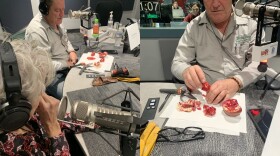People may still be thinking about what to put around their homes to replace lawns. Lawns used to be the go-to solution where children and dogs could play. Rock’s attractive in a way, but doesn’t provide much of a recreation area. I’ve never been a big fan of lawns, although I do like walking through grass in my bare feet. When someone mentions lawns to me, though, my first thought is “do you have livestock?” like cows or sheep.
Still, rock isn’t the only choice for a home landscape. There’s a good number of attractive, low growing plants that can provide greenery and even flowers. And they do it without a huge amount of water.
Most of these are perennial, so once they’re established, you’ll have them for years. As long as you don’t drown them. Don’t let them dry out either. A plant that doesn’t grow tall will usually have a root system that doesn’t grow deep. Shallow root systems tend to dry out quicker, but if you amend the soil with compost when you’re planting, it’ll hold onto moisture better.
So what are some of these terrific substitutes for lawns?
The tallest of these ground covers reaches eight inches, and many of them don’t get above five. And they all have flowers – some are yellow, like you see in so many desert plants, but there’s lots of color. Some are invasive in other parts of the country, but that would require more water than they’re likely to get in your desert garden.
There’s one I won’t advise– Vinca minor. I love this vine; it’s hardy and has purple flowers about an inch across. However, if you don’t keep in check, you’ll have a garden of nothing but Vinca. I’ve had it more than 15 years; now it’s crowding out the mint. I mow it with a string trimmer, and pull out the vines when I trip over them. It’s like mint; terrific if you contain it.
Most others aren’t so problematic. Achillea tomentosa is also known as “wooly yarrow”. It’s evergreen, and the name wooly describes the leaves. The tallest part of this is the stalk that’s all of 8” of yellow flowers.
The scientific name of “Pussy toes”, which has seven other common names, is Antennaria dioica. It’s drought tolerant, likes full sun, doesn’t get much taller than three inches and has flowers in colors from pale pink to red. it spreads to about a foot and a half.
Thyme, which we know is an herb, can be a terrific groundcover. There are many varieties, with flowers from white through purple. Some grow up to a foot, but “creeping thyme” doesn’t get taller than three inches and spreads to a foot. It’ll tolerate our infertile salty soils, our sun, and even drought.
Delosperma is a familiar ground cover with succulent leaves and bright colored flowers that can attract butterflies and hummingbirds. You may know it as “ice plant”. Other low growing plants have that name as well, and they’re also groundcovers.
At the Extension Office, we have big spreads of Dymondia margaretae. It’s so low-growing it’s known as “silver carpet”. And it has tiny yellow flowers. Aside from the oxalis weed that sometimes appears in it, it’s a pretty fool-proof ground cover.
This is just a sample of the pretty little things you might want to try. No, you can’t play soccer on any of these plants, but they are nice to look at, take less water, and you don’t have to mow them.
For KNPR’S Desert Bloom, this is Dr. Angela O’Callaghan of the University of Nevada Cooperative Extension. Stay healthy, my neighbors.







